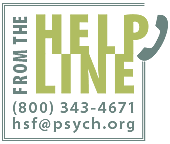APA’s Practice Management HelpLine often receives calls from members whose use of the higher-level CPT medical evaluation and management (E/M) codes is being questioned by payers. Previous to the changes to CPT coding that went into effect in 2013, psychiatrists who saw patients for individual psychotherapy used timed codes that indicated the therapy was provided by a physician (90805, 90807, 90809). These codes paid slightly higher than the nonphysician psychotherapy codes, with the E/M included being valued at approximately the same level as a 99211, the lowest level outpatient E/M service for an established patient, a code that does not even require the presence of a physician.
The coding structure enables psychiatrists who provide their patients with E/M work to be more accurately compensated when they see patients who require a higher level of E/M than the minimal amount that was included in the previous codes in which psychotherapy and E/M were combined. Coding for the psychotherapy provided is selected on the basis of time. While this positive change permits more accurate coding and reimbursement, the use of the same E/M codes used by all physicians has made coding for psychiatric services more complex.
E/M coding can be confusing, and some psychiatrists have found it difficult to understand how to determine the appropriate level of E/M. Although the selection of the correct level of E/M coding is based on the number of elements involved in the history, exam, and medical decision making that occur during the encounter, the decision about whether these elements should be included as part of the patient visit must be based on the patient’s condition during that visit.
For example, you may see a stabilized patient with a number of serious psychiatric and medical diagnoses on a regular basis to ensure that the patient’s condition has not changed. Although the guidelines from the Centers for Medicare and Medicaid Services indicate that the number of diagnoses can drive a higher level of E/M, if the patient is seen bi-weekly and is stable, there is no need to do more than establish that the stability is continuing (which can be done with the lowest level of E/M, 99212) regardless of the patient’s underlying diagnoses. If, however, this same patient has decompensated since the last visit and changes are needed in the treatment regimen, a higher level of E/M is warranted.
Although Medicare seems to be having no problem with payment for the use of the lowest physician level E/M service (99212) along with psychotherapy on a regular, even weekly basis, some larger commercial payers are reported to be balking at the idea that E/M services are necessary on such a frequent basis and have been auditing psychiatrists who code this way or denying payment for either the E/M or the psychotherapy. Remember, even if you’re out of network with an insurer, the patient may be denied reimbursement if the medical record does not support the level of care billed (or may have to return payment previously received if an audit fails to support the level of E/M that was billed). Be sure your documentation records the E/M work you did.
Since traditionally psychiatrists have billed on the basis of time rather than on the severity of the patient’s condition, it seems that an appreciable number of psychiatrists are choosing to use the total time of their visit as a basis for determining the level of the E/M code they bill. Using the “typical time” listed next to each CPT code in the CPT manual, they are billing higher-level CPT codes by spending more time with their patients. However, total time of the visit can be used as a basis for determining the level of the E/M code only if at least half of the time was spent providing “counseling and/or coordination of care, which is defined in CPT as educating the patient and family and/or coordinating the patient’s care with other health care providers. Frequent use of high-level CPT codes often leads to audits by Medicare and private payers. If you provide at least 16 minutes of a recognized form of psychotherapy along with the E/M service, bill the E/M based on the level of history, exam, and medical decision making required with an add-on psychotherapy code and document both the E/M work and the psychotherapy work so each is separately identifiable (this can be two parts of the same note).
In contrast, if you educate the patient and family and/or coordinate care with other health care professionals for at least half the total time of the visit and meet the threshold time for the code in the CPT manual, you can bill on the basis of the total time. Be sure to document both the total time and the time spent counseling and/ or coordinating care, as well as specifying what you educated the patient about or what care was coordinated. For all other E/M services provided, you should bill only on the basis of the complexity of the service and document enough specific history, exam, and medical decision-making elements to meet or exceed that level of care. Otherwise, you will be found to have coded incorrectly, leading to an audit or demands for refunds.
In summary, an important point to remember when selecting the level of E/M coding for a patient visit is that it is generally based on the elements of history, exam, and medical decision making that are required for that specific visit on the basis of the patient’s presentation that day. The selection should not be based on the number of diagnoses a patient has or the overall complexity of the patient’s physical and psychiatric illnesses. If a psychotherapy service is needed and provided, the psychotherapy add-on code is selected on the basis of the time estimated to have been devoted to psychotherapy. You should bill on the basis of time only if more than 50 percent of the entire visit meets the CPT definitions for counseling and/or coordination of care.
The good news is that if you code using the appropriate E/M code and add-on psychotherapy code, it is likely the reimbursement will be equivalent to that if you had just used a higher-level E/M code based on the time of the encounter—and you will not be opening yourself up to audits from payers. ■
More information on E/M coding can be found on the
APA website. If you have specific coding questions, contact the Practice Management HelpLine at
[email protected] or (800) 343-4671.

